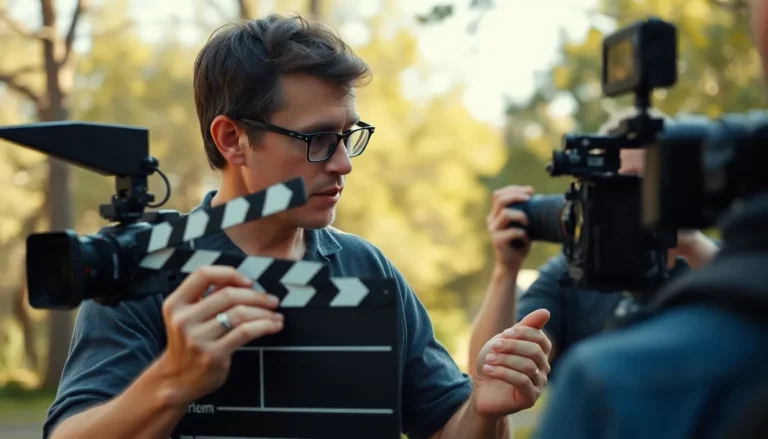Ever watched a film and thought, “What just happened?” If so, you’re not alone. Story analysis in film isn’t just for the critics in turtlenecks sipping espresso; it’s for anyone who’s ever been left scratching their head over a plot twist or wondering why the hero made that questionable choice. Understanding the nuances of storytelling can transform a casual viewer into a savvy cinephile, able to dissect the layers of narrative like a pro.
Table of Contents
ToggleUnderstanding Story Analysis in Film
Story analysis plays a pivotal role in understanding films and their narratives. By examining elements such as character development, plot structure, and thematic depth, individuals uncover the underlying messages conveyed through the storyline.
Characters serve as the heart of any film. Studying their motivations and transformations reveals how they drive the narrative forward. For instance, a protagonist’s journey may mirror societal issues, enabling viewers to connect on a deeper level.
Plot structure consists of essential components like exposition, rising action, climax, falling action, and resolution. Each part contributes to building tension and maintaining audience engagement. Recognizing these elements aids in grasping how filmmakers construct compelling stories.
Themes provide insight into the film’s overall message. They encompass various topics such as love, sacrifice, or redemption. Identifying recurring themes helps viewers understand the filmmaker’s intent and the cultural context at play.
Cinematography and sound design also enhance storytelling in film. Visual elements, such as camera angles and lighting, create atmosphere, while sound effects and music evoke emotions. Analyzing these aspects reveals how technical choices support narrative development.
By learning story analysis techniques, viewers become equipped to deconstruct complex plots and appreciate nuances. Approaching films with analytical skills transforms passive watching into active engagement, enriching the viewing experience. Ultimately, this deeper understanding cultivates a greater appreciation for the art of filmmaking.
Key Elements of Story Analysis

Understanding key elements in story analysis enhances appreciation of film narratives. These elements include narrative structure, character development, and themes.
Narrative Structure
Narrative structure dictates the flow of a film’s plot. Exposition introduces characters and setting, establishing context. Rising action builds tension through conflicts and complications. The climax delivers the turning point in the story, while falling action and resolution provide closure. Each component maintains audience engagement by creating an emotional journey. This structured approach ensures viewers remain invested in characters’ fates, ultimately shaping their viewing experience.
Character Development
Character development reveals the depth and complexity of individuals within the narrative. Motivations drive characters’ actions, causing growth or transformation throughout the film. Conflicts often challenge characters, testing their values and beliefs. As the story progresses, filmmakers showcase these changes, allowing audiences to connect. Relatable characters reinforce engagement, making their journeys resonate personally. Effective character arcs contribute significantly to the film’s emotional impact and message.
Themes and Motifs
Themes and motifs serve as the foundation of a film’s deeper messages. Themes encompass universal topics like love, redemption, or betrayal, offering insight into human experience. Motifs, such as recurring symbols or phrases, reinforce these themes throughout the film. Filmmakers utilize themes to reflect societal issues or evoke emotional responses. Through thoughtful implementation, audiences gain a new understanding of the narrative’s context and the filmmaker’s intent. This exploration enriches the overall viewing experience.
Techniques for Effective Story Analysis
Analyzing film stories requires specific techniques that deepen understanding. Effective story analysis enhances appreciation of cinematic narratives.
Close Reading
Close reading involves meticulous examination of dialogue, imagery, and subtext. Specific phrases can reveal character motivations and thematic elements. Analyzing word choice fosters insight into the filmmaker’s intentions. Repeated motifs often signify core themes, enhancing narrative comprehension. Identifying irony in dialogue shows discrepancies between characters’ perceptions and reality. Evaluating visual cues within scenes enriches textual interpretation, shedding light on underlying messages. This attention to detail transforms a viewer’s grasp of the story, revealing complexities often overlooked in initial viewings.
Scene Breakdown
Scene breakdown dissects individual segments to uncover their functions within the overall narrative. Each scene’s purpose must align with character development and plot progression. Examining transitions between scenes helps identify shifts in tone or focus, contributing to emotional impact. Viewing each scene through the lens of conflict shows how tension drives the story forward. Considering pacing allows analysis of rhythm and timing, affecting audience engagement. Integrating camera angles and techniques reveals how visuals shape perception, complementing the narrative’s emotional resonance. Each element within a scene contributes to the film’s holistic meaning, illuminating the intricacies of storytelling.
Case Studies of Story Analysis in Popular Films
Analyzing popular films reveals extensive layers of narrative complexity. For example, The Godfather showcases an intricate plot structure featuring themes of power and family loyalty. The character arc of Michael Corleone illustrates profound transformation, shifting from a reluctant outsider to a ruthless leader.
Inception also serves as a compelling case study. The film’s non-linear narrative structure mirrors its themes of dreams versus reality. Characters traverse multiple layers of consciousness, enhancing viewer engagement through puzzling plot devices.
Another example, Get Out, employs social commentary as a key theme. The protagonist’s journey highlights racial tensions and personal conflict. Character development drives the story, with Chris’s evolving awareness showcasing personal growth against alarming societal norms.
Regarding animation, Inside Out presents a unique exploration of emotions. The film personifies different emotions, making them central to its narrative. Character interactions lead to an understanding of mental health, promoting a deeper thematic discussion.
Parasite intricately weaves social dynamics into its narrative. The film examines class struggle while utilizing a blend of drama and dark comedy. Each character’s motivations reflect broader societal issues, encouraging audiences to consider their own roles.
Each of these films demonstrates how story analysis illuminates themes, character arcs, and narrative structures. Through careful examination, viewers enhance their appreciation for cinematic storytelling and its impact on culture.
Story analysis enriches the film viewing experience by transforming passive observers into engaged participants. By delving into character development, plot structure, and thematic elements, viewers gain a deeper appreciation for the artistry behind filmmaking. This understanding not only enhances enjoyment but also fosters critical thinking about narratives and their societal implications.
As audiences explore various films through the lens of story analysis, they uncover layers of meaning and emotional depth. The techniques discussed empower viewers to dissect complex plots and engage with films on a more profound level. Ultimately, embracing story analysis opens the door to a richer cinematic journey, allowing individuals to appreciate the intricate tapestry of storytelling in film.




